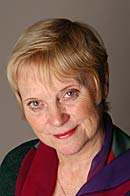There is historic precedence for suggesting that managers who are expected to give presentations should learn the techniques of acting. It comes from the five canons of rhetoric set out by Latin scholars in the year 1 BC, the fourth of which directs that all the techniques available to an actor should be assimilated by anyone wishing to persuade others to take in their ideas.
Performance is submission to the scrutiny and judgement of others. To do that takes courage and brings fear. But the rush of adrenaline which it causes can sometimes disable rather than enable so it must be kept under control. Visualisation is the tool actors use to gain that control.
As you are gearing up to deliver your presentation, run through it in your mind visualising only a perfect performance. If, after that effort, too much adrenaline is still sloshing around your body, quell it further by concentrating briefly on calming images of, say, a moonlit stream.
Take your pulse before and after these momentary visualisations and feel for yourself how readily your body responds to their comforting influence. The dryness in the mouth which usually accompanies fear can be cured by placing the tip of the tongue behind the front teeth and sucking it to stimulate the saliva glands.
Learning from acute observation is another tool in an actor's kit. Attend as many presentations as you can. Watch and listen carefully and make notes as soon as possible afterwards. Incorporate good points into your own work honing them to fit your own style. Avoid things which made you feel ill at ease as an observer.
Actors work with directors who watch out for them and help them to shape their roles. Most presenters have no such mentors but usually have access to a video camera. Make use of one if you can. Watch the results! Otherwise practise in front of a long mirror. You will learn so much from seeing yourself in action.
Sufficient rehearsal is both the safety net and the safety blanket of performance. As long as you have prepared well unexpected disturbances will be easily taken in your stride.
The character of each audience elicits material differently from alert, aware speakers. Know what you want to say. Know why you have to say it. Feel secure in those two objectives and you will make your listeners feel secure.
Actors know well the crucial importance of a good entrance. The power which that moment exerts over the whole of your time in front of your audience is enormous. What you look like, how you deport yourself will be assimilated in the blink of an eye, so don't blow it.
Whether addressing large groups in unfamiliar surroundings or simply presenting to a familiar group around a familiar table in a confined space - take centre stage. Take-in your audience benignly. Make them feel welcome and at ease - they are your invited guests. Be glad that they are there. Smile with your eyes as you breathe in the space you are about to fill with your words.
Focus for a second or two on an imaginary horizon beyond the furthest listeners and keep catching sight of that horizon at various points throughout your interaction with them. Words projected to that horizon will carry beyond it without fail.
Write any notes you are going to use as a script. Indicate pauses clearly. Make sure you don't leave out those short periods of silence when delivering your presentation.
Start with a sentence which is pithy and relevant to your topic then dive in to your subject with an elegant far-reaching dive so that people can perceive your trajectory. Don't immediately disappear down in to the deep-end before they have had chance to take stock of you. Believe that what makes sense in your mind will make sense in your mouth and in your listeners' ears.
Don't be surprised if your throat, back and legs ache after a presentation. Speaking and standing for long periods are both unusual muscular activities. No good actor would take on a role without fitness training, neither should any presenter. Build up stamina by degrees. Relax and breathe out fully between practise sessions and if your throat feels dry - drink!
Voice is powered by controlled use of the out breath and it is you who must learn to be the controller. When you are speaking companionably, looking-at and taking-in a group of friends, you will be animated and, even in a crowded bar, will make yourself heard; being heard in the performance of a presentation is merely an extension of that principle.
The loudness of the voice you hear when there's no hubbub behind you may surprise you - but don't hold it back. The aim is to get used to speaking with those stronger vowels and crisper consonants.
Actors train hard to form clear consonants because they know them to be crucial clarifiers of meaning. Consonants cut through because they jar or flick or buffet listeners' ears, just as percussion instruments do in any band. Make your tongue bustle to and fro and your lips pop and fizz energetically as you form these important conveyors of meaning.
Repeating words like "fuel" or "beautiful " and emphasising the "y" sound in them strongly will help your muscles to get used to the unusual task of propelling your voice quality to the front of your mouth.
Humming into the area of the mouth behind the top teeth and making your nose and top lip buzz will also focus your voice forward and is something you can do whilst walking around the office without being thought too mad.
When a song has a good melody its lyrics are easy to recall. Vary the pitch and pace of your presentation to make your message easy to recall. No subject will seem dull if delivered in a varied and tuneful way
Speaking weightily will seem unnatural at first but so does pumping iron if you've never attempted it before. Muscles learn very fast and given the chance will empower you to grab your listeners ears and wow them in the aisles!
One of the final things actors have to do before a show hits the road is to use and be at ease with a variety of props, and, even when the show has opened check out their own props before each performance. Good presenters should do the same.
Make sure that the visual aids you've chosen to use will really add something to your message. Hiding behind a razzle-dazzle of Power Point slides is not the best way to go mainly because if a screen is up there people attend to what's on it and not to you so you're wasting your breath.
To add genuine point to your presentation use only a few, sharply relevant slides and when you want your audience to attend to them attend to them yourself. Avoid putting out the lights. Human beings tend to sleep when it is dark!
When everything is finally set, actors find their centre of gravity. They breathe out before breathing in. They stand upright, head supported by an upright back and shoulders, feet slightly apart, one foot a little in front of the other, knees slack - a posture which will keep them balanced for hours - and take-in their audience.
By finding your own centre of gravity and using your new found skills you too will be confident in the act of presentation and forge another firm link in the chain connecting us to presenters who strove for gravitas over two millennia ago.

